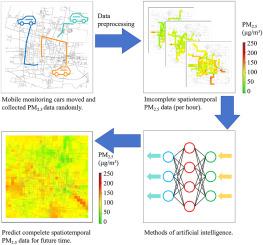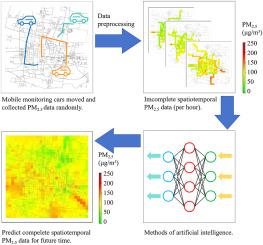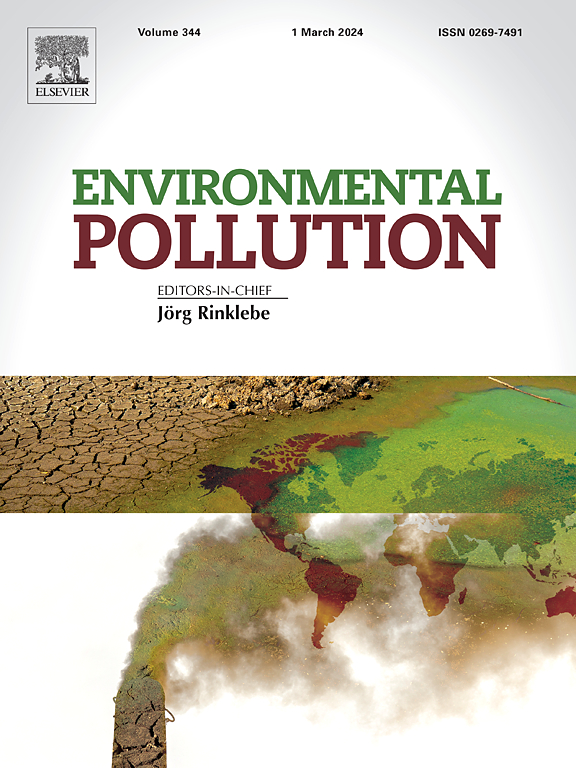基于移动监测和深度学习的 PM2.5 浓度高分辨率时空预测
IF 7.6
2区 环境科学与生态学
Q1 ENVIRONMENTAL SCIENCES
引用次数: 0
摘要
获取城市空气污染物的高分辨率分布特征对于有效控制污染和公众健康至关重要。为此,与传统的固定监测方法相比,移动监测提供了一种新颖实用的方法。然而,由于移动监测数据的稀疏性,要恢复整个区域的高分辨率污染物浓度仍然是一个挑战。为了解决稀疏性问题,实现对 PM2.5 时空分布的预测,本研究提出了一种基于移动监测数据的高分辨率城市 PM2.5 预测方法。该方法的空间分辨率为 500m × 500m,时间分辨率为 1 小时。首先,利用移动监测的 PM2.5 浓度和外源特征训练光梯度提升机(LightGBM),以获得完整的时空 PM2.5 浓度。其次,建立了一个由卷积神经网络和变压器(CNN-Transformer)组成的模型,并定制了损失函数,以根据完整的时空数据预测高分辨率 PM2.5 浓度。该方法利用从中国沧州收集的实际数据进行了验证。交叉验证的数值结果显示,估算的 R2 为 0.925,预测的 R2 为 0.887,表明该方法适用于基于移动监测数据的 PM2.5 浓度高分辨率时空预测。本文章由计算机程序翻译,如有差异,请以英文原文为准。


High-resolution spatiotemporal prediction of PM2.5 concentration based on mobile monitoring and deep learning
Obtaining the high-resolution distribution characteristics of urban air pollutants is crucial for effective pollution control and public health. In order to fulfill it, mobile monitoring offers a novel and practical approach compared to traditional fixed monitoring methods. However, the sparsity of mobile monitoring data still makes it a challenge to recover the high-resolution pollutant concentration across an entire area. To tackle the sparsity issue and fulfill a prediction of the spatiotemporal distribution of PM2.5, a high-resolution urban PM2.5 prediction method was proposed based on mobile monitoring data in this study. This method enables prediction with a spatial resolution of 500m × 500m and a temporal resolution of 1 h. First, a Light Gradient Boosting Machine (LightGBM) was trained using mobile monitoring of PM2.5 concentration and exogenous features to obtain complete spatiotemporal PM2.5 concentration. Second, a model consisting of Convolutional Neural Network and Transformer (CNN-Transformer) with a customised loss function was established to predict high-resolution PM2.5 concentration based on complete spatiotemporal data. The method was validated using real-world data collected from Cangzhou, China. The numerical results from cross-validation showed an R2 of 0.925 for imputation and 0.887 for prediction, demonstrating this method is suitable for high-resolution spatiotemporal prediction of PM2.5 concentration based on mobile monitoring data.
求助全文
通过发布文献求助,成功后即可免费获取论文全文。
去求助
来源期刊

Environmental Pollution
环境科学-环境科学
CiteScore
16.00
自引率
6.70%
发文量
2082
审稿时长
2.9 months
期刊介绍:
Environmental Pollution is an international peer-reviewed journal that publishes high-quality research papers and review articles covering all aspects of environmental pollution and its impacts on ecosystems and human health.
Subject areas include, but are not limited to:
• Sources and occurrences of pollutants that are clearly defined and measured in environmental compartments, food and food-related items, and human bodies;
• Interlinks between contaminant exposure and biological, ecological, and human health effects, including those of climate change;
• Contaminants of emerging concerns (including but not limited to antibiotic resistant microorganisms or genes, microplastics/nanoplastics, electronic wastes, light, and noise) and/or their biological, ecological, or human health effects;
• Laboratory and field studies on the remediation/mitigation of environmental pollution via new techniques and with clear links to biological, ecological, or human health effects;
• Modeling of pollution processes, patterns, or trends that is of clear environmental and/or human health interest;
• New techniques that measure and examine environmental occurrences, transport, behavior, and effects of pollutants within the environment or the laboratory, provided that they can be clearly used to address problems within regional or global environmental compartments.
 求助内容:
求助内容: 应助结果提醒方式:
应助结果提醒方式:


